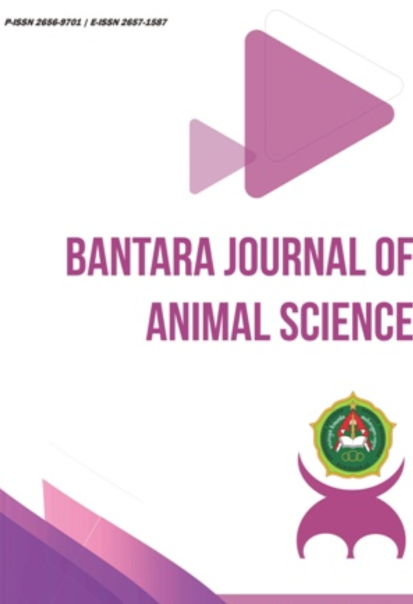Organoleptic Quality of Salted Quail Eggs Using Boiled Salt From Brebes
DOI:
https://doi.org/10.32585/bjas.v3i1.1327Abstract
Salted eggs are one of the popular products and are liked by the people of Indonesia. Processing salted quail eggs is an effort for preservation, in addition to improving the taste of quail eggs This study aims to determine the organoleptic quality of quail eggs salted with fine boiled salt with a concentration of 20% (w/w) and 30% (w/w). The incubation time for the salting process is 4 days. organoleptic test with 60 untrained panellists. Yolk colour quality produces a slightly yellow colour (p>0.05). The aroma of salted quail eggs is slightly fishy (p>0.05). Taste quality has a difference (p<0.05) where the 20% salt concentration treatment produces a bit less salty, while the 30% salt concentration treatment produces a slightly salty taste. The tasting test did not have a difference between treatments (P>0.05) which produced unsubstantiated eggs, and the panellists' organoleptic test on average resulted in a preference for the 30% salt concentration treatment.
Downloads
References
Ariviani, S., Fitriasih, N.H., Ishartini, D., 2018. Development of low sodium salted eggs and its antioxidant potential. J. Gizi dan Diet. Indones. (Indonesian J. Nutr. Diet. 5, 51.
Borsato, D., Moreira, M.B., Moreira, I., Pina, M.V.R., Silva, R.S. dos S.F. da, Bona, E., 2012. Saline distribution during multicomponent salting in pre-cooked quail eggs. Food Sci. Technol. 32, 281–288.
Franke, T.M., Ho, T., Christie, C.A., 2012. The Chi-Square Test: Often Used and More Often Misinterpreted. Am. J. Eval. 33, 448–458.
Gómez, I., Janardhanan, R., Ibañez, F.C., Beriain, M.J., 2020. The effects of processing and preservation technologies on meat quality: Sensory and nutritional aspects. Foods 9, 1–30.
Goswami, M., Pathak, V., Singh, V., Nayak, N., Upadhyay, S., 2013. Effect of natural preservatives on sensory and microbiological properties of quail egg pakoda. Indian J. Poult. Sci. 48, 313–317.
Kaewmanee, T., Benjakul, S., Visessanguan, W., 2011. Effects of Salting Processes and Time on the Chemical Composition, Textural Properties, and Microstructure of Cooked Duck Egg. J. Food Sci. 76.
Novia, D., Juliyarsi, I., 2019. Quality characteristics of salted egg soaked with Aloe vera solution. Int. J. Adv. Sci. Eng. Inf. Technol. 9, 434–440.
Nur’aini, Suningsih, N., Hakim, M., 2020. Organoleptic Test of Salted Eggs with Addition of Herbal Plants. Indones. J. Agric. Res. 3, 171–178.
Nurliyani, N., Hartawan, A., Nugroho, Y.A., Indratiningsih, I., 2015. The Characteristics of Salted Chicken and Duck Egg by Using Traditional Roasting 738–742.
Patanggara, E. U. H., V. D. Yunianto, B. Sukamto, and L. Krismiyanto. 2019. The use of calcium in quails during egg hatching phase by adding yacon leaf powder (Smallantus sonchifolius). Bantara J. Anim. Sci. 1(1) : 21-27.
Sousa, R. de C.S., Coimbra, J.S.R., Garcia Rojas, E.E., Minim, L.A., Oliveira, F.C., Minim, V.P.R., 2007. Effect of pH and salt concentration on the solubility and density of egg yolk and plasma egg yolk. LWT - Food Sci. Technol. 40, 1253–1258.
Sumekar, W., Al-Baarri, A.N., 2020. Study in Agroindustry of Salted Egg: Length of Salting Process and Marketing Reach Aspects. J. Appl. Food Technol. 7, 25–28.
Tan, T.C., Phatthanawiboon, T., Mat Easa, A., 2016. Quality, Textural, and Sensory Properties of Yellow Alkaline Noodles Formulated with Salted Duck Egg White. J. Food Qual. 39, 342–350.
Tharukliling, S., Fanani, Z., 2018. Effect of Use Different Eggs with Different Techniques of Salted Eggs on the level of Consumer Preference. J. Dev. Res. 2, 15.
Wang, T.H., 2017. Salting yolks directly using fresh duck egg yolks with salt and maltodextrin. J. Poult. Sci. 54, 97–102.
Wang, Z.F., Dai, C., Wang, T.Y., 2017. A simple method to evaluate oil in salted egg. Int. J. Food Prop. 20, 1816–1822.
Wibawanti, J.M.., Meihu, M., Hintono, A., Pramono, Y.B., 2015. The Characteristcs Of Salted Egg In The Presence Of Liquid Smoke. J. Appl. Food Technol. 3, 193–198.
Xianglei, T., Meijuan, R., Qin, Z., Guangpeng, L., 2013. Study on the granulation texture of salty yolk. Adv. J. Food Sci. Technol. 5, 613–618.
Xu, L., Zhao, Y., Xu, M., Yao, Y., Nie, X., Du, H., Tu, Y. gang, 2017. Effects of salting treatment on the physicochemical properties, textural properties, and microstructures of duck eggs. PLoS One 12, 1–17.





